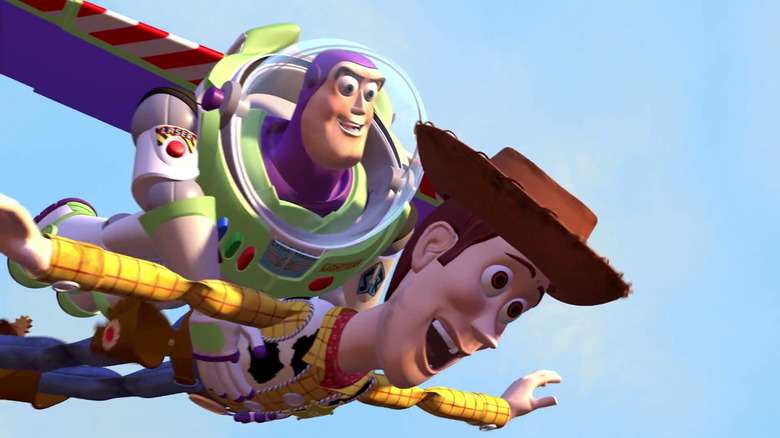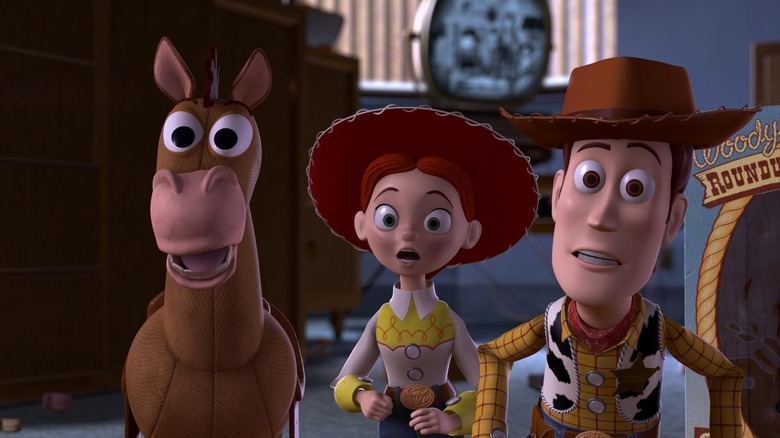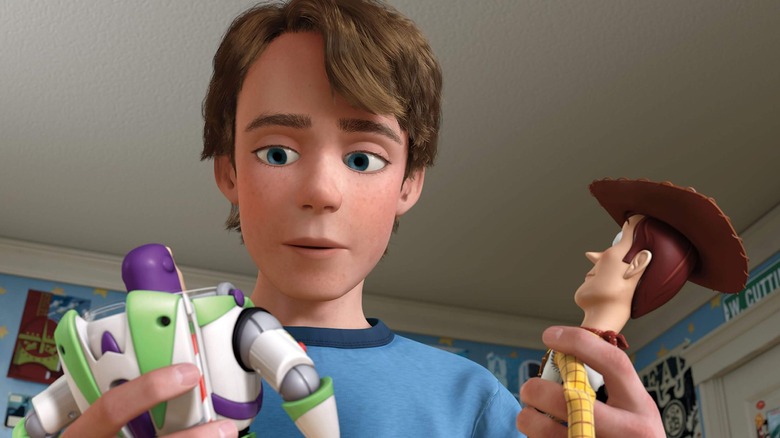The Two Toy Story Movies That Have A Perfect Rotten Tomatoes Score
It's astonishing to look back at John Lasseter's 1995 film "Toy Story" and regard how rudimentary it looks by today's standards. "Toy Story" was the first widely distributed CGI-animated feature film, and it felt overwhelmingly revolutionary at the time. Many were astonished at how expressive and fun CGI characters could be, and the film's success effectively ushered in a sea change in the animation world. In 2024, traditional cel animation is incredibly uncommon, and CGI is the naturally assumed standard.
CGI characters are designed to essentially be "puppets," in terms of their elasticity. Animators, at least at the time, were forced to stay on-model, only able to expand eyeballs or raise eyebrows so high. It wouldn't be for years that CG characters could mutate, squash, and stretch the way hand-drawn characters could. "Toy Story" benefitted from being about, well, toys. Its characters were all made of plastic, so there was an organic reason for their skin to look "too smooth" and for their faces to be only partially expressive.
To date, there have been six "Toy Story" feature films, if one counts the Buzz Lightyear spin-off movie "Buzz Lightyear of Star Command: The Adventure Begins" and the "Lightyear" film about the man who inspired the toy. There has also been a Buzz Lightyear animated TV series, a Forky animated series, two TV specials, and four short films. In February 2024, it was confirmed that "Toy Story 5" was in the works.
Of those, only two have a 100% approval rating on Rotten Tomatoes. It may come as no surprise that the 1995 original is one of them, but it may surprise readers to learn that the 1999 follow-up "Toy Story 2" is the other. This is surprising, given how overwhelmingly beloved "Toy Story 3" was when it came out in 2010.
Toy Story (1995) and Toy Story 2 (1999)
"Toy Story 2" was Pixar's third feature film, coming after the release of the then-liked-but-now-ignored "A Bug's Life" in 1998. The sequel followed up on Woody the Cowboy (Tom Hanks) and Buzz Lightyear the Spaceman (Tim Allen) as they became separated. It had been agreed by the living toys in Andy's room that Buzz and Woody were co-captains of the group, seeing as they were the toys Andy played with the most. Woody, however, turns out to be a rare collectible and a greedy toy collector kidnaps Woody and places him alongside other rare cowboy toys — Jessie (Joan Cusack) and Stinky Pete (Kelsey Grammer) — released decades before. Because of the way memories work in the "Toy Story" universe, Woody (seemingly) has no recollection of being packaged and stored on a shelf.
It will later be revealed that Stinky Pete is bitter and cruel because he's a collectible still being held in his original packaging. Because no children opened the box to play with him, he has become mean and despondent. The purpose of toys, as we all know, is to be played with, not collected. "Toy Story 2" might serve as a subtle criticism of adult Disney collectors who keep children's playthings sealed in plastic.
Of the 171 critics who reviewed "Toy Story 2" for Rotten Tomatoes, every single one of them gave it a pass. Not all of the reviews were rated four stars, but no one felt bitter enough to rate it lower than a "thumbs up," as it were. Speaking of "thumbs up," Roger Ebert gave the film 3.5 stars out of four.
Not Toy Story 3?
These days, the general consensus seems to be that "Toy Story 3" is the best film in the series. But of the 312 critics who reviewed it, five thought it wasn't up to snuff. Yes, the infamous contrarian Armond White wrote one of the negative reviews.
"Toy Story 3" takes place a decade after "Toy Story 2" when Andy, the toys' owner, is 18 and moving away to college. Andy might take a beloved childhood toy with him — just one — but it would be for nostalgia's sake, not because he's still playing with toys. "Toy Story 3" is about how toys do indeed have a life cycle and that they have something similar to old age. Eventually, all toys will be put in a box and stored in an attic, or they'll be given to a preschool to be abused by babies. Or, perhaps most tragically, they'll be thrown away, destined to be burned in a furnace at a landfill.
"Toy Story 3" is a comedic children's film about geriatrics and mortality. It also contains one of the weepiest moments in Pixar's history (which is saying something!) when Andy slowly gives away all his childhood toys to a new kid named Bonnie to play with. Take care of Woody, new child. He's brave. Not a dry eye in the house.
White, perhaps rightly, noted that however emotionally fraught and thematically rich "Toy Story 3" might have been, it was difficult to get past the phenomenon of branding. "Toy Story" is a film, after all, that celebrates children being branded by major toy companies, a phenomenon that kicked into high gear back in the 1980s. Eileen Jones likewise said that nostalgia is the enemy.
I guess that gave "Toy Story 2" the edge.


